Section.2
Drug discovery research based on individual immunological differences
We aim to establish immunological analysis systems, search for biomarkers, and establish new preventive and therapeutic methods directly related to human clinical applications by comparing human clinical specimens, genetically modified mice as animal models, and non-human primate monkey specimens on a side-by-side basis. Our major research focuses on cancer-related research and infectious disease-related research.
- 1. Development of Immunotherapy to Cure AIDS
- 2. New COVID-19 vaccine development research
- 3. Establishment of mRNA/saRNA vaccine development platform
- 4. Development of a universal influenza vaccine
- 5. Immunological studies against hepatitis B virus to enable functional cure
- 6. Exploratory study of surrogate markers predictive of HTLV-1 infection (ATL/HAM)-related pathogenesis
◆ Infectious Disease Related
1. Development of Immunotherapy to Cure AIDS
HIV is the causative virus of acquired immunodeficiency syndrome (AIDS), and even now, more than 30 years after its identification, there are approximately 35 million infected people worldwide. In Japan, the number of people infected with AIDS is on the rise, with nearly 20,000 people thought to be infected, and it remains one of the most serious emerging and reemerging infectious diseases. However, it is not possible to completely eliminate latent virus-infected cells from the body, and once cART is initiated, patients must continue to take the drugs for the rest of their lives. However, it is not possible to completely eliminate latent virus-infected cells from the body, and once cART is started, patients must continue taking the drug for the rest of their lives. In other words, in HIV-1 treatment, eliminating latent infected cells that remain in the body after cART treatment is considered to lead to so-called functional cure or cure of AIDS.
To achieve functional cure, it is important to 1) reactivate latent infected cells and induce death of infected cells by cellular degeneration effect (CPE) and 2) induce strong activation of anti-HIV-1 immune response mainly by CD8 T cells. Therefore, we are conducting research to establish a novel immune activation therapy that can strongly induce the above two immune responses in combination with the current cART.
[Abstract Figure] Novel T-cell-based immune activation therapy for the treatment of AIDS.
![[Overview chart] Novel T-cell-based immune activation therapy for the treatment of AIDS](/assets/img/work/Fig2_JP.png)
2. New COVID-19 vaccine development research
COVID-19 related studies
The novel coronavirus SARS-CoV-2 is still spreading worldwide since it was first reported in Wuhan, Hubei Province, China in December 2019.Against this backdrop, mRNA-based vaccines from Pfizer and Moderna were approved early and are now being administered to people all over the world. On the other hand, there are still many things that remain to be elucidated about how mRNA vaccines, a new platform, react in the human body. In addition, we are still dependent on vaccines produced overseas, and domestic vaccines have not yet been approved. Under these circumstances, we are conducting research on the following topics.
1. Elucidation of the importance of cellular immunity
The COVID-19 mRNA vaccine contributes to infection protection by inducing a particularly strong antibody response, but its effect against the newly emerged mutant Omicron strain was limited.On the other hand, cytotoxic CD8 T cells (CTL), which directly eliminate infected cells, show reactivity against the mutant strain and may contribute to suppressing severe disease after breakthrough infection (Nogimori et al, Frontiers in Immunology, 2023). In other words, the key to suppressing pandemics is how to efficiently induce CTL responses in order to deal with SARS-CoV-2 mutant strains and unknown coronaviruses that are likely to emerge in the future. However, the phenotype of CD8 T cells that may contribute to the suppression of severe disease in the event of breakthrough infection has not yet been fully elucidated. In collaboration with Osaka Public University, we are working to elucidate the immune mechanism that suppresses breakthrough infection by comparing the immune response induced in vivo and subsequent breakthrough infection during long-term follow-up of mRNA vaccine recipients. Furthermore, in collaboration with Osaka University, we are examining mRNA vaccine efficacy in liver transplant patients taking immunosuppressive drugs. By utilizing this valuable cohort of patients and pursuing the relationship between mRNA vaccine efficacy and CD4 and CD8 T-cell responses, we are working to elucidate the overall picture of immune responses induced by the new platform of mRNA vaccines.
[Overview chart] Role of this project in the development of new vaccines:
Evaluation of efficacy and safety
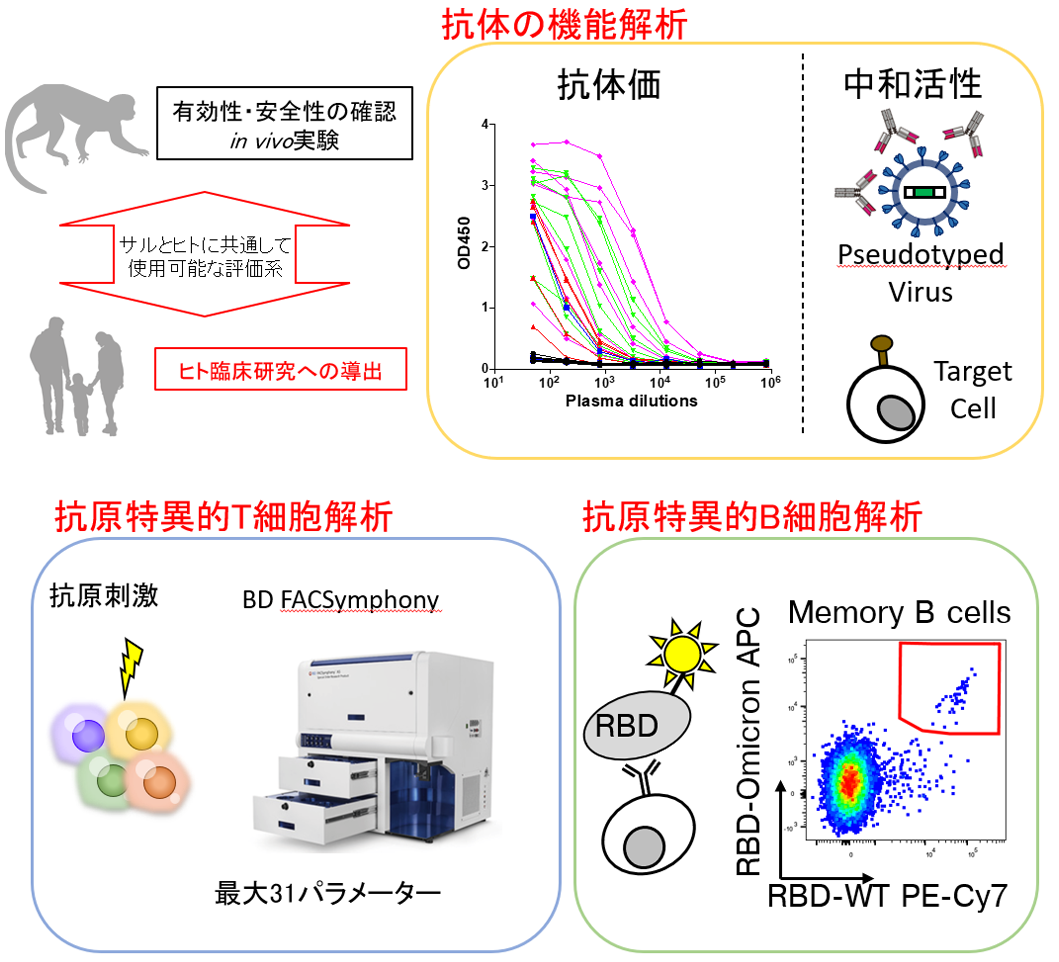
2. Development of a novel replicon RNA vaccine against novel coronaviruses
海外製のmRNAワクチンは日本国内でも多くの方に接種されてきました。国産ワクチンに関しては、各製薬会社が開発を進めていますが、いまだ承認されていません。SARS-CoV-2の新たな変異株の出現や、全く新しい感染症の出現に迅速に対応するためには、国内でのワクチン製造プラットフォームを構築することが非常に重要であると考えられてい ます。 我々はVLP therapeutics社、名古屋医療センター、北海道大学と共同して自己増殖型(レプリコン)RNAワクチンの開発を行なっています。 この研究グループの中で特に我々は、非臨床試験及び臨床試験で得られた血液検体についてハイパラメーターフローサイトメーターを用いて詳細に解析することで、ワクチンの有効性・安全性評価を行なっています。 レプリコンRNAワクチンといった全く新しいワクチンプラットフォームを構築することで、新興再興感染症出現時に国内で迅速に対応可能となることを目指しています。
尚、このプロジェクトは、AMED「新型コロナウイルス感染症(COVID-19)に対するワクチン開発 」に採択されております。
[Overview chart] The importance of cellular immune response in mRNA vaccine efficacy.
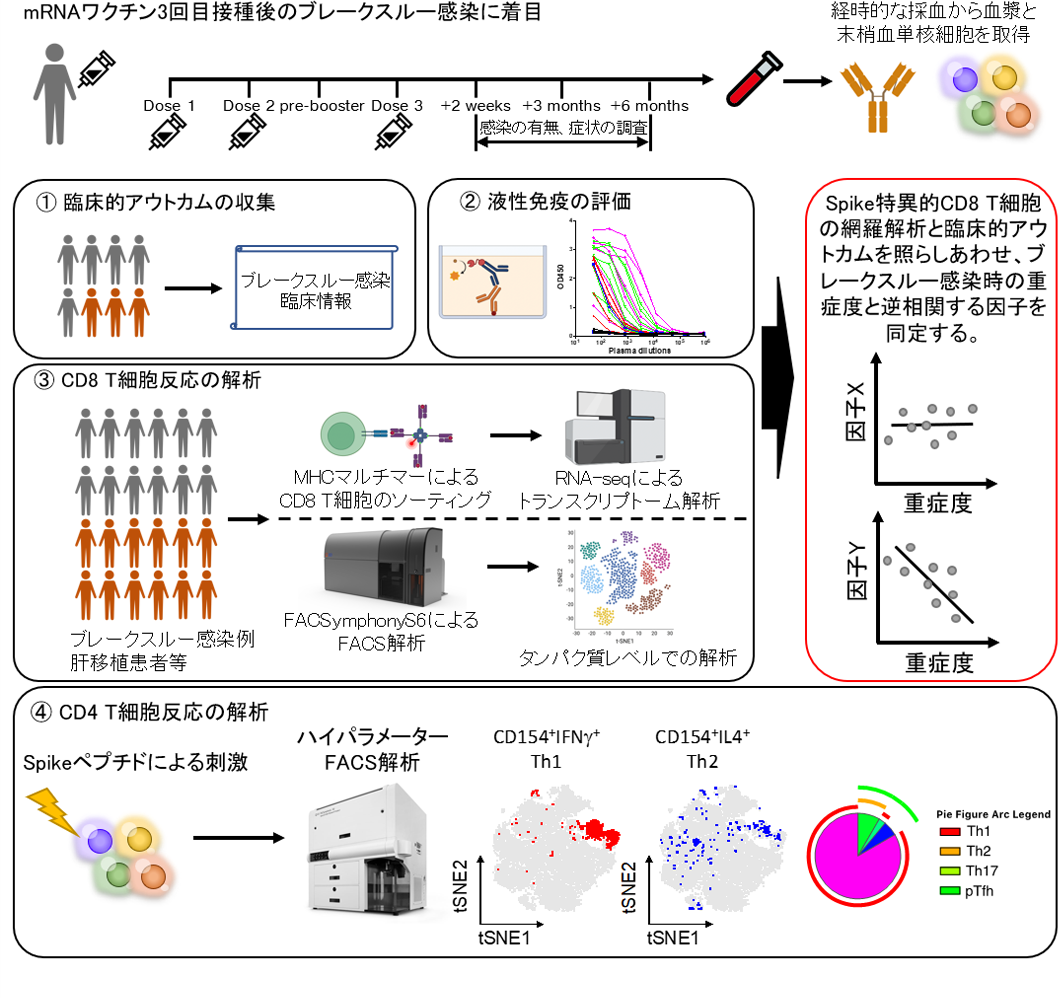
3. Development of a CTL-guided tandem vaccine against novel coronaviruses
We are aiming to develop a SARS-CoV-2 vaccine that induces an effective CTL response against SARS-CoV-2 and can be used against various mutant strains of SARS-CoV-2.We are also working with VLP therapeutics, Nagoya Medical Center, and Hokkaido University to search for antigens (epitopes) that efficiently induce CTL responses, and to design self-amplifying RNA (saRNA ) vaccine constructs that artificially link multiple types of epitopes. This project has been adopted by the AMED "Vaccine and New Modality Research and Development Project: Development of Vaccines for Infectious Diseases against Priority Infectious Diseases".
[Overview chart] Development of a CTL-guided tandem vaccine against novel coronaviruses
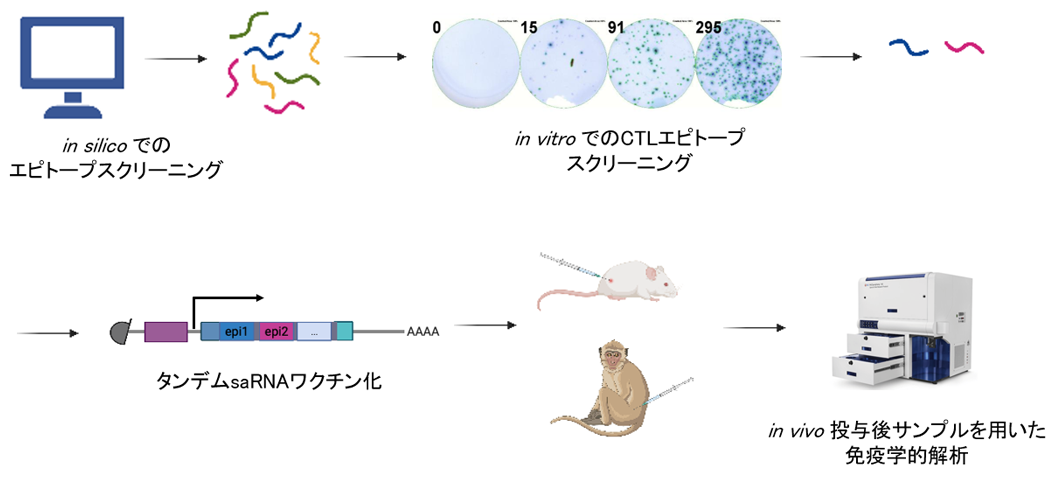
3. Establishment of mRNA/saRNA vaccine development platform
under construction
4. Development of a universal influenza vaccine
Influenza is an infectious disease caused by the influenza virus. Every year there are epidemics in many parts of the world, and about 15 million people are affected by influenza each year. Influenza viruses are polymorphic, with influenza types A and B in particular being prevalent worldwide. Hemagglutinin (HA) and neuraminidase (NA), which are glycoproteins, protrude from the surface of the virus particles, and the combination of these proteins results in multiple subtypes (H1N1, H3N2, H5N1, etc.), making it a highly diverse virus.
The split-type vaccine used as the current seasonal influenza vaccine is a quadrivalent vaccine that predicts the prevalent type and generally targets four types of viral glycoproteins: one type from H1N1, one type from H3N2, and two types from type B, in total.However, HA is prone to mutation, and vaccine efficacy is not effective against mutated viruses, so there is an urgent need to develop vaccines that can respond to mutated virus strains.In addition, as the population ages, there is a growing need to develop an effective influenza vaccine as part of measures against infectious diseases in the elderly.
我々は国立感染症研究所と大日本住友製薬株式会社との共同研究において、従来の製造方法とは異なったワクチン抗原と、大日本住友製薬株式会社において独自に開発中のアジュバントを組み合わせた万能インフルエンザワクチンの開発研究を行なっています。この万能インフルエンザワクチンのウイルス抗原の精製方法は、国立感染症研究所免疫部の高橋先生のグループにより開発されたもので、ワクチンにより「HA抗原の中でも変異が起きにくく、かつ異なるHA 型のウイルス間でも保存された領域に対する抗体」を誘導できる可能性が示唆されています。このワクチン抗原に大日本住友製薬株式会社により開発中の新規アジュバントを組み合わせることで、夢の万能インフルエンザワクチン開発の実現を目指しています。
Our group is contributing to this collaborative research by evaluating the safety and efficacy of this vaccine for practical use, especially by conducting immunological analysis in primate models using a next-generation high-parameter flow cytometer.
[Overview chart] Drug discovery research for infectious diseases based on immune aging phenomenon
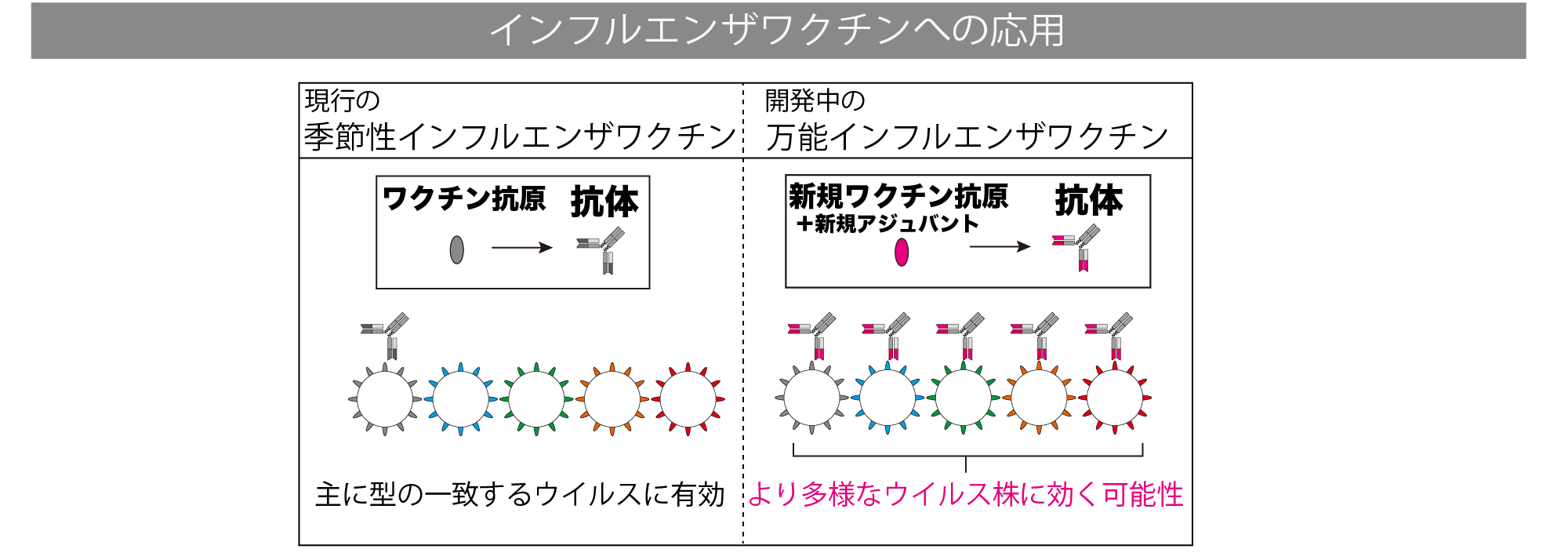
5. Immunological studies against hepatitis B virus to enable functional cure
Hepatitis B Virus (HBV) is the causative virus of hepatitis B. In the natural course of chronic hepatitis B caused by HBV infection, about 90% of patients do not progress to cirrhosis and only about 10% progress to liver cancer.The involvement of immune response has been suggested as one of the factors that determine the pathogenesis of these conditions. In addition, the fact that HBV is eliminated in 95% of cases when the immune system is normal after initial infection in adulthood and that the HBV vaccine has a certain effect leaves no doubt about the importance of the immune response in controlling HBV. On the other hand, nucleic acid analogs are mainly used in the current treatment of chronic hepatitis B and liver cirrhosis, and the progression to cirrhosis and liver cancer can be controlled to some extent by lowering HBVDNA levels. However, even with long-term use of nucleic acid analogs, only about 3-4% of HBs antigen is eliminated. In other words, even if nucleic acid analogs reduce HBV DNA in the blood below detection sensitivity, HBV replication template and HBV genome remain in hepatocytes in many cases, which may lead to hepatocarcinogenesis. Therefore, the current clinical therapeutic goal is the elimination of HBs antigen, which is thought to correlate with the risk of carcinogenesis.
Immunological studies on hepatitis B virus suggest that a functional cure may be possible.Functional cure is not the complete elimination of the virus, but rather the cessation of liver inflammation by controlling the virus and minimizing liver damage. To achieve functional cure, it is necessary to eliminate the virus in liver cells, which requires an immune response against HBV-infected cells.For this reason, immunological studies of the hepatitis B virus are important.Although various immunological studies have partially elucidated the mechanism of the immune response to hepatitis B virus, the response of hepatitis B virus-specific T cells to various HBV surface antigens (HBsAg) and core antigens (HBcAg) has not yet been fully elucidated (Figure).
In order to achieve a functional cure, we are conducting this research in close collaboration with many domestic collaborators including the Hepatitis Immunology Research Center of the National Center for Global Health and Medicine, aiming to first reduce HBV DNA below the detection limit by nucleic acid analog therapy and then eliminate remaining HBV infected cells through immune response.
[Overview chart] functional cureを可能とする
B型肝炎ウイルスに対する免疫学的研究

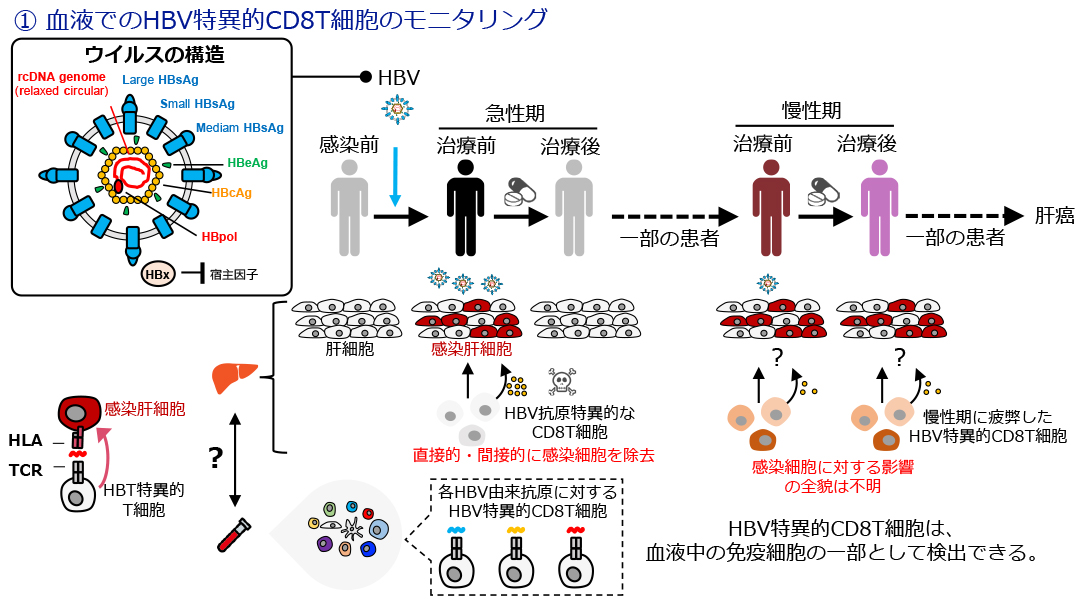
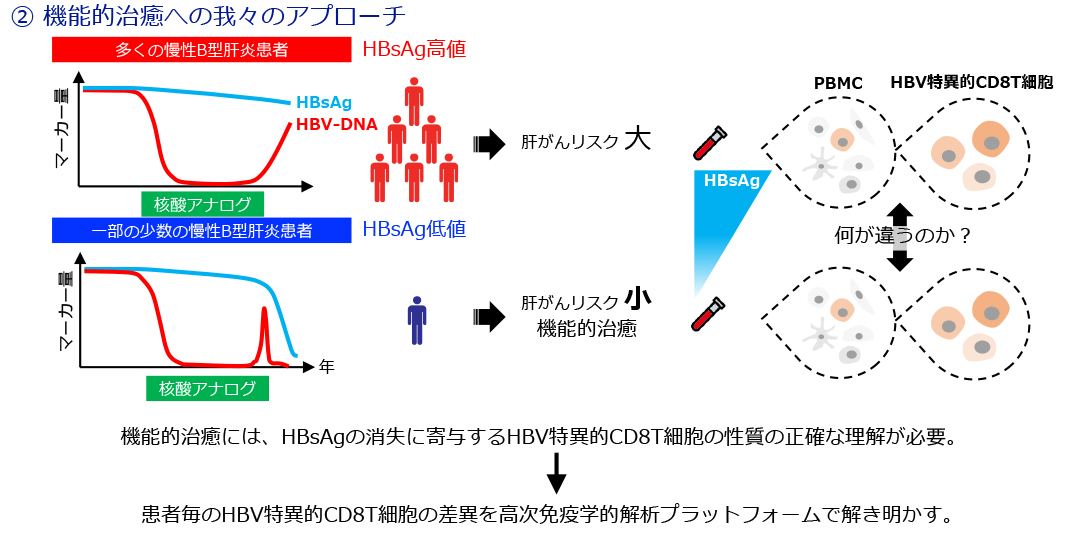
6. Exploratory study of surrogate markers predictive of HTLV-1 infection (ATL/HAM)-related pathogenesis
under construction
◆ cancer-related
1. Development of novel cancer immunotherapy for pancreatic cancer and other refractory cancers
Pancreatic cancer has a very poor prognosis among gastrointestinal cancers, with an overall 5-year survival rate of less than 10%, and the main reason for this is that early diagnosis is extremely difficult.Although many studies have been conducted to discover early diagnostic markers, no more useful tumor markers than existing ones have yet been found, and only 30-40% of patients are eligible for surgical treatment, the only curative treatment at the time of diagnosis. Another reason for the poor prognosis of pancreatic cancer is that it is difficult to be treated with anticancer drugs and there are only a few effective anticancer drugs available.
The development of novel cancer immunotherapies for pancreatic cancer and other refractory cancers is currently at the forefront of cancer treatment. In this field, methods to attack cancer cells by activating T cells have attracted much attention T cells are one of the major cells in the immune system and play a central role in the immune response T cells can attack cancer cells, but to prevent excessive immune responses, cancer cells have developed ways to escape from the immune system They have developed a way to escape. This is called immune surveillance escape. In cancer immunotherapy, methods to activate T cells are used to circumvent this immune surveillance escape. One particularly well-known method is immune checkpoint molecular inhibition. In this method, inhibitory antibodies are administered against inhibitory molecules (immune checkpoint molecules) that promote T-cell activation, thereby facilitating T-cell attack on cancer cells. As an example, antibodies that inhibit the interaction between PD-L1, an immunosuppressive molecule produced by cancer cells, and PD-1, an immune checkpoint molecule on the surface of T cells, have been developed. This allows the activation of T cells to be promoted. Another way to activate T cells is to use proteins produced by cancer cells or specific proteins present on the surface of cancer cells as antigens for T cell activation. These proteins are expected to be recognized by T cells, thereby increasing the number of T cells attacking cancer cells. In addition, a wide variety of therapies have been developed to promote cancer cell attack by T cells, including immune checkpoint inhibitors and CAR-T cell therapy using cell therapy. In recent years, while the above-mentioned immunotherapies have been found to be useful in other cancers, their efficacy in pancreatic cancer has been found to be limited. Why do pancreatic cancers show such resistance to treatment? How is the immune system affected by anticancer drugs and surgery? It is very important to elucidate the pathogenesis of pancreatic cancer, including what kind of immune response occurs in the body under the condition of pancreatic cancer, in order to establish an effective treatment for pancreatic cancer in the future (Figure 1). We collaborated with multiple institutions (Department of Gastroenterological Surgery, Department of Surgery, Osaka University, Department of Gastroenterological Surgery, Osaka International Cancer Center, and Department of Gastroenterological Surgery, Osaka Acute Care Medical Center) to conduct a joint research on immunological profiles of blood cells (mainly T lymphocytes) in pancreatic cancer patients at various time phases and tissue obtained during surgery, using a next-generation We are analyzing the immunological profiles of blood cells (mainly T lymphocytes) and tissues obtained at the time of surgery in various phases of pancreatic cancer patients using a high-parameter flow cytometer and gene expression analysis to elucidate the mechanism of immune response to pancreatic cancer (Figure 2). Furthermore, based on the results of these studies, we will attempt to identify markers that will be useful for early diagnosis of pancreatic cancer, determination of treatment efficacy, and prediction of prognosis.
[Overview chart] 膵がんをはじめとする難治性がんに対する
新規がん免疫療法の開発
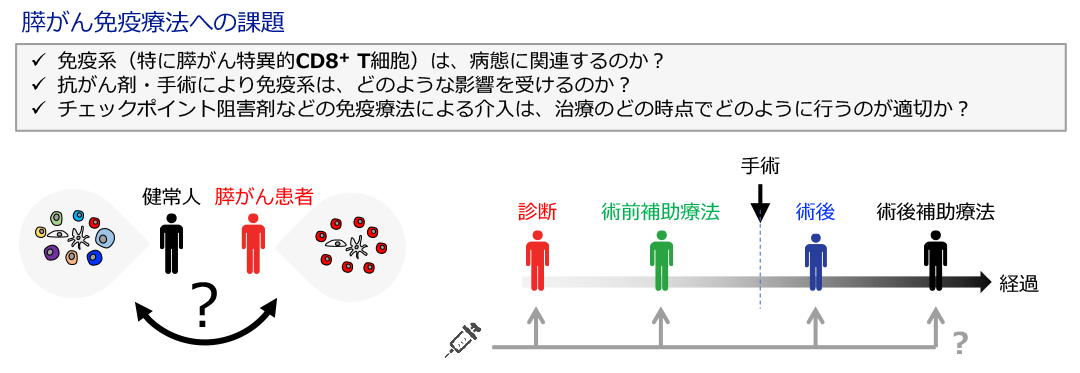
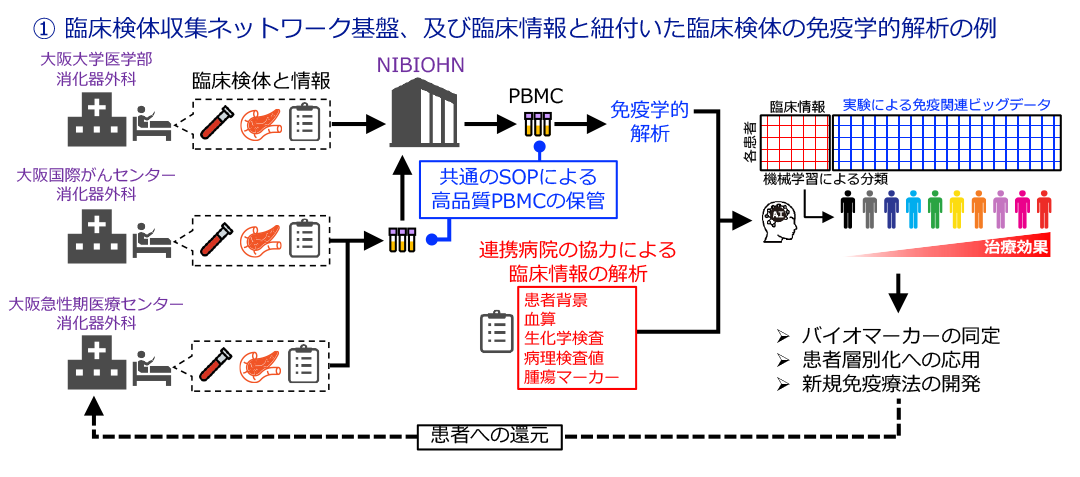
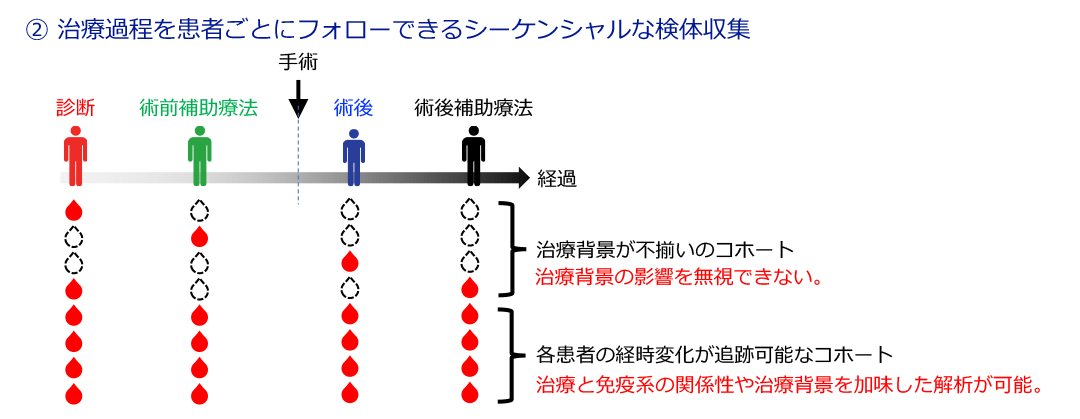
2. Development of a novel cancer immunotherapy for melanoma
under construction
